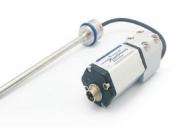
Hotline:
0750-6163878
( Ms Zhang )
Phone: 18929003382
Fax: 0750-6703782
Address: East Industrial Zone, Huicheng Town, Xinhui District, Jiangmen city
URL: www.shoujichina.com
How to modify the waveguide wire of magnetostrictive displacement sensor?
1. Correction method for the influence of waveguide wire surface discontinuity on detection signal
Use the weak reflected signal to find the orientation of the unconnected part. The method is as follows: first place the magnetic ring on the upper end, sample the echo signal, and then find the characteristic points (such as peak) of the echo signal at the float and the reflected signal at the unconnected part The interval between the two can be calculated, so as to calculate the positive orientation of the unconnected part. The directions of the unconnected parts are found out, and the measured values of the float in different directions are corrected by using the conclusion of the above test. When the amplitude is attenuated by 1/2, the magnetic ring is set in front of the unconnected part, and this conclusion can be fully used when writing the correction algorithm. No matter what kind of defect, you can refer to the above methods for correction, and use the phenomenon of reflection after the magnetic ring to find the location of the defect. So as to judge the advantages and disadvantages of waveguide wires and select good waveguide wires.
2. Influence of fixing method at the bottom of waveguide wire on detection signal and correction method
Since the changed ultrasonic wave propagates to both ends, the change that occurs when it propagates to the bottom is related to the fixing method. There are three fixing methods for the bottom of waveguide wire: damper fixing method, steel fixing method and unfixed device. How will these fixed methods affect the detection signal? Select a magneto elastic displacement sensor with a measuring range of 1 meter to test and observe its influence.

The test results are shown in the figure below. To be eye-catching, translate the steel body fixing method downward by 1 unit and the method without fixed devices downward by 2 units. It can be clearly seen that these three fixed methods only affect the amplitude of the signal It has no effect on the phase of feature points. It is also found in the test that no matter which fixing method is used, the detection signal will not be affected as long as the magnetic ring at the bottom of the waveguide wire is more than 4cm apart. Although the torsional wave propagates to both ends, generally only one echo is used to measure the interval, and the reflected echo at the bottom of the waveguide wire is not used.
3. Influence of remanence phenomenon in waveguide wire on detection signal and correction methods
The waveguide wire is made of magnetic material, which will be magnetized in the magnetic field, and the inner part of the movable magnetic ring of the magnetoelastic displacement sensor is a permanent magnet. Theoretically, as long as the magnetic ring passes through, the waveguide wire may be magnetized, and there is a magnetic field at the magnetization, but this magnetic field is very weak compared with the magnetic field generated by the magnetic ring
First let the magnetic ring move on the waveguide wire several times, and then remove the magnetic ring. Repeat this test several times and observe the changes before and after. As shown in Figure 7, it can be seen that there is indeed magnetization in the place where the magnetic float passes by, and there will also be magnetoelasticity in the magnetized place, but the signal is relatively weak. Looking at the second, third and fourth curves, the directions of remanence in these three curves are surprisingly similar, indicating that the formation of remanence once will not disappear due to the repeated movement of the float.
In the test of selecting comparator, it is also found that some orientations of waveguide wire show stable positive errors (+6mm), some orientations of plane show stable negative errors (-5mm), and some local errors are very small, which is almost equal to positive real values. Remanence phenomenon well explains the causes of these errors. If the phase difference between the magnetoelastic signal of the magnetic ring and the magnetoelastic signal of the current remanence phenomenon is 180 degrees, the superposition of the two signals will show a small value, and then a positive error will appear. If the phase is the same, it will show a large value, and then it will show a negative error.
In the magnetoelastic displacement sensors, almost all of them show stable positive and negative errors. A large number of experiments have confirmed that this error is caused by the phenomenon of geomagnetism. This requires that we need to deal with the magnetic illusion and demagnetize each time the magnetic ring moves to a new direction. Only in this way can we deal with the stable errors of the sensor.
In application, the magnetic ring can be removed first or placed on the upper end, and then the signal is sampled. According to the sampled signal, whether there is a magnetic field in the waveguide wire can be judged.
Article source: magnetostrictive displacement sensorhttp://www.shoujichina.com